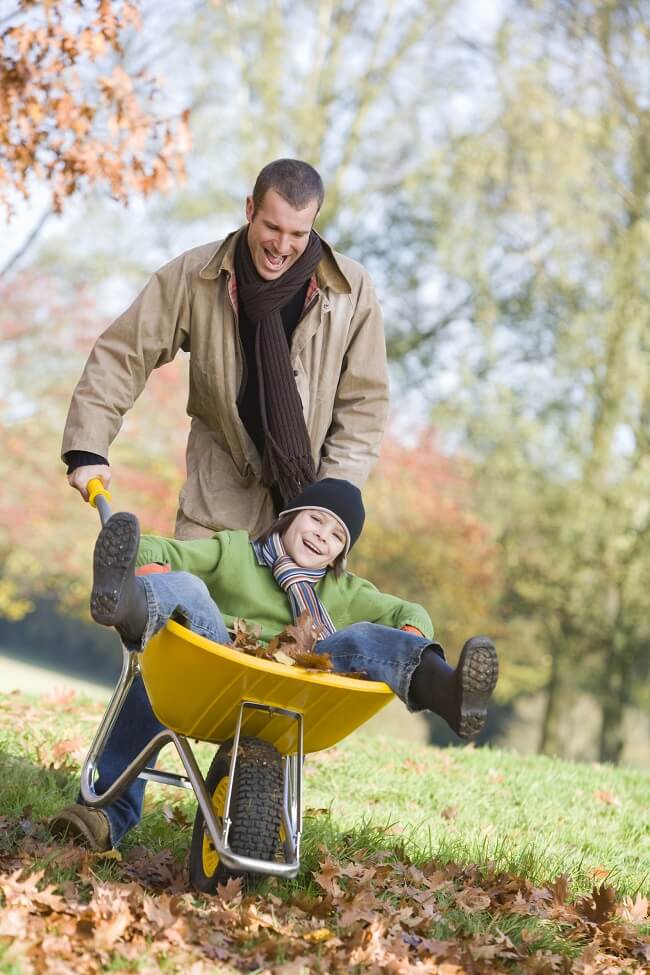Over the years we’ve written a number of guides on looking after your home’s plumbing, heating, and cooling. With this post, we wanted to help you out by including the best fall home maintenance tips from everyone here in the office. You’ll find this list covers all the essentials. While not every task will apply to you (for example, you may not own a pool), every tip is short and sweet so you can skip anything that doesn’t apply to you.
As with any work around the house, the hardest part is usually getting started. The trick is to start early and do a little every weekend so you’re not left with a monster weekend full of huge chores.
The other challenge is that you’re also on a deadline – all of these things need to be done before the temperature dips below freezing and the snow flies. When that happens is sometimes hard to predict. But getting them done will potentially save you thousands of dollars in damages, replacement fees, and of course the headaches that go along with them.
One more tip on getting motivated: for outdoor tasks, try and get them done on a beautiful fall day when you really want to be outside.
OK, let’s get started…
1. Put Away Summer Equipment
Clean and store any patio furniture, your barbecue, and kids’ summer toys. If you have a pool, winterize and cover it. If you’ve left any gardening equipment out, store that as well – except what you need for raking leaves of course!
Concrete and ceramic planters will need to be emptied and stored to prevent cracking. Replace them with fiberglass all-weather planters with a seasonal arrangement.
2. Prepare Your Deck
Give your deck a good sweep. To see if your deck needs resealing, sprinkle some water: if it gets absorbed right away it’s time to reseal. Doing this in the fall prevents damage from the freezing and thawing of winter ice.
To save water and your wood, we don’t recommend using a power washer to clean your deck. Instead, you can thoroughly clean your deck with a commercial cleaner before resealing. For more information you can follow these steps.
* If there’s no water shortage and you really want to use a power washer, set it to the gentlest setting and test it on an area that’s generally hidden from view. Most power washers can shred the soft wood used for most decks very quickly.
3. Tidy and Cover Your Air Conditioner
Over the summer, the area around your AC may have gotten covered in leaves, dirt, and debris, and nearby shrubs may have grown in too close. Trim them back, and tidy the area so you have 2 feet of clear space around the air conditioner. Cover the unit to protect it from snow and ice.
4. Trim and Inspect Trees and Shrubs
Remove any dead branches from shrubs and small trees. If you spot any large branches that are dead or dying, you may want to remove them so they don’t come down in a winter storm.
Wrap any bushes that aren’t hardy for our climate, and inspect your garden for signs of disease and infestations.
5. Lawn Maintenance and Yes, Raking the Leaves

Raking leaves can be a nice way to enjoy the fall, especially if you have small kids and pets who will add some fun to the mix. If your kids are older, more hands make for faster work. A special seasonal dessert can help motivate the grumblers (we would do anything for homemade apple pie, for example). Once the leaves are cleared away, inspect your lawn for patchy areas and reseed them. Fertilize if needed.
6. Clean Gutters
Once the leaves around your home have mostly fallen, ensure your gutters and downspouts are clear. Clumps of leaves can cause meltwater to back up and even lead to flooding. If you’re doing this yourself, don’t wait too long because you’ll need to go up a ladder. It’s not very safe if you’re facing a howling gale and sleet that’s horizontal.
While you’re up there, take some time to inspect the roof. Are there any damaged or missing shingles? Are there any low spots that could indicate a problem? What about the seals around any rooftop vents?
7. Turn off Your Outdoor Taps and Irrigation Systems
Because water expands when it freezes, it can burst pipes. Locate the pipe that leads to your outdoor tap (often in the basement) and turn off the valve. Then, go to your outdoor tap and turn it all the way on. You should get a bit of water, then nothing. At that point the pipe is empty so go ahead and turn the tap off. Don’t forget to drain any hoses and store those away too.
8. Inspect Your Home’s Exterior
Take a tour around the exterior of your home and see if any new holes in the siding have appeared. It may be that critters are making themselves at home. In the fall, any babies should have left their mothers so you should be able to evict the squatters with a clear conscience.
Check the condition of weatherstripping around doors and sealing around windows to ensure there aren’t any cracks. Check the condition of the foundation – again you’re looking for cracks or missing layers of concrete. Don’t forget to test any railings on stairs, decks, and porches.
9. Check Your Walkways, Driveway, and Car
Tour your walkways and driveway and ensure you repair any cracks – if you don’t they’ll get worse over the winter as the ground freezes and heaves. They’re also a safety hazard, as ice and snow can hide cracks or lifted edges.
Ensure you have enough ice-melter on hand (we like the plant-friendly kind), and check the condition of your snow shovel and snow blower. Make sure you check your car’s ice scraper, block heater, and tires as well. It won’t hurt to have some extra bottles of windshield washer fluid on hand. Add a cylinder of lock de-icer to your bag or coat pocket too, just in case.
10. Check Safety and Security Alarms
Take the opportunity to test your carbon monoxide and smoke alarms and replace any batteries if needed. If you have a security alarm, arrange a test for that as well. Not everyone knows it, but radon can also be a problem in Calgary, and now is a good time to have your home tested.
11. Ensure your Furnace has a Clean Filter
Clean or replace your furnace filter so it’s ready to turn on. You don’t want to have to do this on that first really cold morning. Test that your thermostat is working and don’t forget to schedule a tune-up so your furnace is performing as efficiently as possible all winter long. If you have a humidifier, check it and if it has a filter pad, replace it.
If you have a fireplace, get your chimney cleaned and if you need wood ensure you have a good supply ready to go.
12. Reverse the Direction of Your Ceiling Fans
Cold air falls and hot air rises, so adjust your ceiling fan to push warm air down off the ceiling so you can get the benefit. In some cases (especially if you have high ceilings), it can make enough of a difference that you may be able to turn the thermostat down and save yourself some money. In summer, BTW, ceiling fans should be creating an updraft to pull cool air off the floor.
13. Have Drains Cleaned and Sump Pump Inspected
We never know what we’re going to get when spring thaw arrives, so ensure your sump pump is working. Check your backwater valve as well if you have one – we recommend them for year-round sewer line backup prevention.
Fall is also a good time to have your drains cleaned, especially if you’ll be having guests around the holidays.
14. Clean Your Windows
While this one is technically optional, you’ll find that if you do it really makes a difference. After a season of dust, insects and rain streaks it’s a good time to give your windows a clean, inside and out. You’ll get a better view of that first snowfall! Washing window screens can help keep your windows clean longer.
And Finally…Relax!
Now that your home’s ready to endure the winter, it’s time to relax with your favorite hot drink and plan that winter vacation.
Looking for more guides to winter prep? Here’s more detail on how to prepare your furnace for winter.






